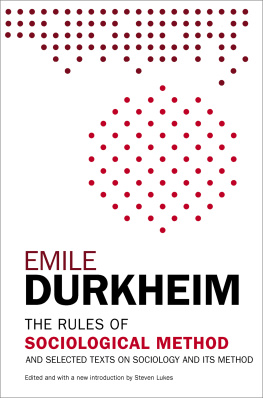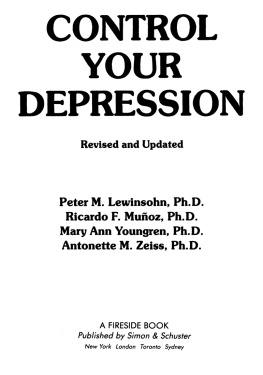Suicide
A STUDY IN SOCIOLOGY
Emile Durkheim
THE FREE PRESS
New York London Toronto Sydney

Copyright 1951 by The Free Press, A Corporation
Copyright renewed 1979 by The Free Press, A Division of Macmillan Publishing Co., Inc.
All rights reserved, including the right of reproduction in whole or in part in any form.
THE FREE PRESS and colophon are trademarks of Simon & Schuster Inc.
Manufactured in the United States of America
Library of Congress Cataloging-in-Publication Data is available.
ISBN 978-0-6848-3632-4
eISBN-13: 978-1-439-11826-9
www.SimonandSchuster.com
To Those Who, with Durkheim, Understand the Life of Reason As Itself a Moral Commitment, and Especially to Arthur D. Gayer in Economics; Sol W. Ginsburg in Psychiatry; Robert S. Lynd in Sociology; and Arthur E. Murphy in Philosophy
CONTENTS
EDITORS PREFACE
OF THE four major works of the renowned French sociologist, Emile Durkheim, only Le Suicide has remained to be translated. The Elementary Forms of the Religious Life was first published in English in 1915; the Division of Labor in Society in 1933 and The Rules of Sociological Method in 1938. Over half a century has gone by since the first edition of Le Suicide, yet far more than antiquarian interest attaches to it in the sociological, statistical, philosophical, and psychological disciplines. But the historical significance of the volume in social thought would be enough reason for presenting it to readers in the English-speaking world. As a milestone in social science and an indispensable part in understanding the work of the man who founded and firmly established academic sociology in France and influenced many others outside of France, it should have long since been available in translation.
Though our statistical material today is more refined and broader, and our socio-psychological apparatus better established than was Durkheims, his work on suicide remains the prototype of systematic, rigorous and unrelenting attack on the subject with the data, techniques, and accumulated knowledge available at any given period. Indeed, Le Suicide is among the very first modern examples of consistent and organized use of statistical method in social investigation. In the last decade of the nineteenth century when Durkheim was conducting the investigations incorporated in this work, repositories (governmental or private) of statistical information on this, or any other subject, were either rare, skimpy, or badly put together. With characteristic energy and the aid of some of his students, especially Marcel Mauss, Durkheim realigned the available statistics so as to answer the question posed by the general problem and its internal details. At the time, statistical techniques were little developed, and Durkheim was forced at given points to invent them as he went along. The elements of simple correlation were unknown except among the pathfinders in statistical techniques like Galton and Pearson, as were those of multiple and partial correlation, yet Durkheim establishes relationships between series of data by methodological perseverence and inference.
The tables which Durkheim drew up have been left in the translation in their somewhat quaint form, with no attempt to set them up according to present-day standards of statistical presentation. They have that way an historical value, as well as a character of their own. To embellish them would take away the atmosphere in which they were literally forged through necessity. Though more recent data are available, the kind of information Durkheim was trying to impart through them is still the kind that sociologists and actuarialists are interested in. Indeed, one table (on the effect of military life on suicide) has been taken over bodily in one of the best general, recent treatises on suicide.
The maps which Durkheim placed in the text have been put in Appendices here, along with a special table which Durkheim drew up but could not use for reasons he gives in a footnote to it. The maps have been reproduced as they are with the French titles and statistical legends.
But in addition to its historical and methodological import, Le Suicide is of abiding significance because of the problem it treats and the sociological approach with which it is handled. For Durkheim is seeking to establish that what looks like a highly individual and personal phenomenon is explicable through the social structure and its ramifying functions. And even the revolutionary findings in psychiatry and the refinement and superior competence of contemporary actuarial statistics on this subject have yet to come fully to grips with this. We shall have more to say of it in the introduction.
There are those, moreover, who look upon Le Suicide as still an outstanding, if not the outstanding, work in what is called the study of social causation.
Finally, Le Suicide shows Durkheims fundamental principles of social interpretation in action. His social realism, which sees society as an entity greater than the sum of its parts, with its accompanying concepts of collective representations and the collective conscience, is here applied to a special problem-area, and the results are some of the richest it has ever borne. For Durkheim not only enunciated methodological and heuristic principles (as pre-eminently in The Rules of Sociological Method) ; he also tested them in research of no mean scope. That his work would have to be supplemented, added to, revised, and our knowledge advanced, he would be the first to admit, since he rightly saw scientific endeavor as a great collective undertaking whose findings are handed on from generation to generation and improved upon in the process.
The translation has been made from the edition which appeared in 1930, thirteen years after Durkheims death and thirty-three years after the first edition in 1897. This edition was supervised by Marcel Mauss. Professor Mauss, in his brief introductory note there, tells us that it was not possible, because of the method of reprinting, to correct the few typographical and editorial errors. With the aid of Dr. John A. Spaulding, I have sought by textual and statistical query, to rectify them wherever they could be discovered.
No index appeared in the French text, and none has been prepared here. Instead, the detailed table of contents which Durkheim drew up has been translated and placed at the back of this book.
For the version of the translation here, I must take full responsibility. Dr. Spaulding and I worked over the first draft, then we both re-worked the second draft. But the final changes I made alone.
Mr. Jerome H. Skolnick, a student of mine, aided in checking the typescript and in proof-reading. He did not confine his work to routine, and many of his suggestions proved to be of great value to me.
GEORGE SIMPSON
The City College of New York
November 1, 1950.
All of these are now published by the Free Press.
Dublin, Louis I, and Bunzel, Bessie, To Be or Not To Be, New York, 1933, p. 112-113.
See especially, MacIver, R. M., Social Causation, New York, 1942.
See, for example, Parsons, Talcott, The Structure of Social Action, Glencoe, Illinois, 1949.
EDITORS INTRODUCTION THE AETIOLOGY OF SUICIDE
I
THE range of Emile Durkheims analysis of the interconnectedness of suicide with social and natural phenomena is so wide and varied as to preclude treatment of all its avenues and by-roads in the short space of this introduction. Within the confines of one not over-long volume, Durkheim has treated or touched on normal and abnormal psychology, social psychology, anthropology (especially the concept of race), meteorological and other cosmic factors, religion, marriage, the family, divorce, primitive rites and customs, social and economic crises, crime (especially homicide) and law and jurisprudence, history, education, and occupational groups. But a short appraisal is still possible because throughout Durkheims work on each and all of these topics subsidiary to suicide, is the basic theme that suicide which appears to be a phenomenon relating to the indi vidual is actually explicable aetiologically with reference to the social structure and its ramifying functions.













